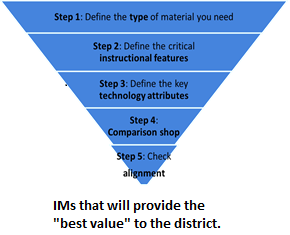Purchasing an online material these days is more like purchasing a car than a textbook. Why? Because the price of online materials is determined by the product’s components and features rather than simply by its instructional content. Federal and state purchasing laws require districts to competitively procure materials to identify the product(s) that will provide the best value for the district. However, attempting to compare online adaptive materials to e-books to textbooks can feel like an apples-to-oranges comparison.
While buying new materials has become a far more complex task than it used to be, it does not need to be overwhelming. These five steps will help you compare products (no matter which format(s) they come in) and identify materials that will provide the “best value” for your district.
Step 1: Define the type of the instructional materials to be selected.
Since price is dependent on a product’s features and functionality, define the type/scope of product your students and teachers need.
- What purpose will the material serve? This analysis will help you determine whether you need a comprehensive, full-year product or a targeted supplemental resource:
- Will it be the primary resource for the course?
- Will it be used to complement another resource or to (re)teach certain standards?
- Will it be used for RtI , extension activities, or credit recovery?
- Are you looking for practice problems to prepare your students for testing?
- What format(s) must the material come in?
- How much bandwidth can your campus/district support?
- Do all students have internet access at home?
- Are your teachers tech savvy or would some prefer a product in print format?
Step 2: Identify the must-have instructional content and features.
Some districts have multi-page “rubrics” for selecting materials. If your teachers have to spend hours looking for hundreds of features in each material, they will likely miss the forest for the trees. Having too many criteria also makes it difficult to compare materials, especially if the materials come in different formats.
A more efficient and likely more effective way to approach the selection of materials is to identify the critical instructional features that will assure your teachers that the product you select will support their teaching. For example:
- Standards Addressed: Does the product at least address the standards you need it to teach? Publishers typically provide a correlation with their material which identifies the standards they believe the material addresses. As explained in Step 5 (below), once you have narrowed the number of products you are seriously considering, it is advisable to check carefully each material’s alignment to those standards before you make your final selection decision.
- Instructional Model: Is the material’s instructional model consistent with the model your curriculum is based upon?
- Organization: Is the content organized logically and consistently throughout? Is the order of the instruction consistent with your district’s curriculum?
- Rigor: Is the material grade-appropriate and rigorous enough for your students? How does it build critical and higher order thinking skills?
- Focus: Does the instruction focus primarily on teaching the priority standards for the grade/course?
- Coherence: How does the material build on prior learning and scaffold instruction?
- Engagement: Does the material contain relevant, real-world examples and activities to engage students?
- Adaptions: Does the material contain the adaptions necessary so that all of your students will be able to use and benefit from it?
- Instructional Resources: Does the material include the resources your teachers need to help them teach the subject/course effectively?
- Ease of Use: How easy is it for your teachers and students to find particular content in the material? For example, does it have a good table of contents /glossary and/or search functionality?
- Assessments: What type and how often does the material assess student learning? Does the material provide teachers with the type of feedback that will help them adjust their instruction?
Step 3: Define the key technology attributes.
In order to get any value from a product, it must work on your district’s and students’ technology. You should check at least the following technology attributes in any of the materials you are considering purchasing:
- Delivery of Core Instructional Content: If you purchase an online product, the core instruction may also need to be available offline for students who do not have access to the internet or devices at home. Is the core instructional content available online only, or is it also downloadable or printable? Will you need a local server to house the product?
- Device /Operating System Compatibility: Does the material (including instructional videos, interactive features, and tools) work on the devices and operating systems your students and teachers will be using.
- Bandwidth: Does your campus/district have the requisite bandwidth capacity to support the simultaneous use of the material?
- Ease of Use/Interoperability: Will your teachers need professional development (PD) to use this material? If so, is sufficient PD included in the price of the product or will you need to purchase additional PD? Does the product work with a single sign on? Is it compatible with your district’s LMS or SIS and software programs? How do teachers/district staff upload, refresh and exit students and teachers in the product?
- Privacy: How does the product protect individually identifiable student data? Who owns the data collected?
Step 4: Comparison shop to find the type product you need at the best price.
As mentioned above, prices of materials differ significantly these days, and there is no relationship between a material’s price and its alignment percentage or any other single feature. In other words, features and functionality drive product prices. Once you have defined the type of material you need, the instructional features and technology attributes it must have, comparison shop to identify one or two materials that meet those criteria at the best price.
Step 5: Ensure the material is aligned to your state’s standards.
Finally, carefully review the alignment of your top two product choices, before you make the final selection decision. Districts spend millions of dollars on instructional materials that go unused because once purchased, teachers quickly discover that the material is not aligned to the state’s standards.
The publisher’s correlation should identify the specific pages/videos/lessons (“citations” in the material) that they believe are aligned to each standard. Most educators will tell you, however, that publishers’ definition of alignment is more liberal than theirs.
Because judging a material’s alignment is an inherently subjective endeavor, it is advisable to have multiple (at least two) experienced teachers who know and understand the state standards, check the alignment of citations listed in the publisher’s correlation. If you do not have the time or staff to check the alignment of every citation in the publisher’s correlation, then just verify the alignment of two or three citations for 10 state standards.
Federal and state laws require districts to competitively procure materials in order to ensure that the products they purchase provide the best value to the district. However, no matter how much time and effort you expend selecting an instructional material, if it is not designed to fulfill the purpose you are purchasing it for, or if it does not have the instructional qualities that will engender your teachers’ confidence, or if it is not compatible your district’s technology or if it is not well aligned to state standards, then the materials you purchase will not provide any value for your district. The steps outlined above should make that analysis and the task of purchasing new online materials a little easier.











